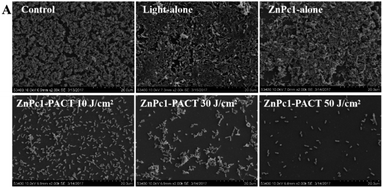 Open Access Article
Open Access ArticleCreative Commons Attribution 3.0 Unported Licence
Correction: Photodynamic antimicrobial chemotherapy with cationic phthalocyanines against Escherichia coli planktonic and biofilm cultures
Min Lia,
Bingjie Maia,
Ao Wangc,
Yiru Gaoa,
Xiaobing Wanga,
Xin Liua,
Shanshan Songa,
Quanghong Liua,
Shaohua Wei*b and
Pan Wang*a
aKey Laboratory of Medicinal Resources and Natural Pharmaceutical Chemistry, Ministry of Education, National Engineering Laboratory for Resource Developing of Endangered Chinese Crude Drugs in Northwest of China, College of Life Sciences, Shaanxi Normal University, Xi’an 710062, China. E-mail: wangpan@snnu.edu.cn; Tel: +86-29-8531-0275
bSchool of Chemistry and Materials Science, Jiangsu Key Laboratory of Biofunctional Materials, Jiangsu Collaborative Innovation Centre of Biomedical Functional Materials, Key Laboratory of Applied Photochemistry, Nanjing Normal University, Wenyuan Road No. 1, Nanjing 210023, China. E-mail: shwei@njnu.edu.cn
cInstitute of Chemical Industry of Forest Products, Chinese Academy of Forestry, No. 16, Suojin 5th Village, Nanjing 210042, China
First published on 31st October 2022
Abstract
Correction for ‘Photodynamic antimicrobial chemotherapy with cationic phthalocyanines against Escherichia coli planktonic and biofilm cultures’ by Min Li et al., RSC Adv., 2017, 7, 40734–40744, https://doi.org/10.1039/C7RA06073D.
The authors regret that incorrect versions of Fig. 7F (Control) and Fig. 8A (Light-alone) were included in the original article. The corrected versions are shown below. The correction does not change any results or conclusions of the original paper.
 | ||
| Fig. 7 Membrane integrity detected by PI staining. (F) Images taken by fluorescence microscope of E. coli treated with 5 μM ZnPc2 in different groups. | ||
 | ||
| Fig. 8 SEM images of PACT-subjected E. coli biofilms. (A) Images of E. coli treated with 20 μM ZnPc1-PACT in different groups. | ||
The Royal Society of Chemistry apologises for these errors and any consequent inconvenience to authors and readers.
| This journal is © The Royal Society of Chemistry 2022 |
